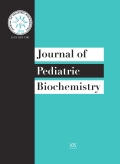Authors: Zahran, Samer M. | Hamed, Enas A. | Awean, Galia Z.A. | Abdel-Hafez, Nagla M. | Hassan, Youssef S.
Article Type:
Research Article
Abstract:
Burn is an injury which is not only devastating for the patients but also puts a great burden on the society by consuming enormous health care resources. Despite improvements in burn wound care and treatment, understanding the role of key pro-/anti-inflammatory cytokines in pathogenesis of burn injury, sepsis and survival requires clarification. This work aimed at measuring plasma levels of the following cytokines: leptin, tumor necrosis factor (TNF)-α, interleukin (IL)-6, transforming growth factor
…(TGF)-α, and basic fibroblast growth factor (bFGF), procalcitonin (PCT) and C-reactive protein (CRP) in children with thermal burn (n=42; 22 males and 20 females with an age range of two months up to 7 years) vs. sex and age matched healthy controls (n=26; 12 males and 14 females with an age range of six months up to 8 years). The venous samples were drawn from patients at 2nd and 8th day postinjury. The relationship between measured plasma cytokines with length of hospital stay, total burn surface area (TBSA), sepsis, survival and complete blood count were investigated. The fatality rate was 28.6% (n=12). At the 2nd day of postinjury, burn cases showed significantly higher values of WBC, CRP, PCT, TNF-α, IL-6, leptin, bFGF, and TGF-α than healthy controls. At the 8th day of postinjury, sepsis caused further significant elevations of WBC, CRP, PCT, TNF-α and IL-6 levels but significantly lower TGF-α levels than cases without sepsis. At the 8th day of postinjury, patients with larger TBSA (> 30%) demonstrated significantly higher values of WBC, CRP, PCT, TNF-α, and IL-6, but significantly lower levels of bFGF and TGF-α than cases with smaller TBSA (⩽30%). At the 8th day of postinjury, non-survivors showed significantly higher levels of WBC, CRP, PCT, TNF-α and IL-6, but significantly lower levels of leptin, bFGF, and TGF-α than survivors. Correlation studies showed significant positive correlation between TBSA and each of IL-6, TNF-α and leptin levels. Except for bFGF and TGF-α levels that were reduced, the increases in other parameters (PCT, TNF-α and IL-6) were directly proportionate to the burn severity, sepsis and fatality. Both bFGF and TGF-α correlated with poor prognostic burn healing in severe septic cases. PCT and/or IL-6 are valuable biomarkers for early detection of burn infections. TGF-α, bFGF and leptin being immuno- and angiogenic modulators might reduce inflammation and post-burn immune dysfunction and enhance burn healing.
Show more
Keywords: Pediatric thermal burns, sepsis, C-reactive protein, transforming growth factor-α, tumor necrosis factor-α, interleukin-6, leptin, procalcitonin, basic fibroblast growth factor
DOI: 10.3233/JPB-2011-0029
Citation: Journal of Pediatric Biochemistry,
vol. 1, no. 4, pp. 279-288, 2011
Price: EUR 27.50





